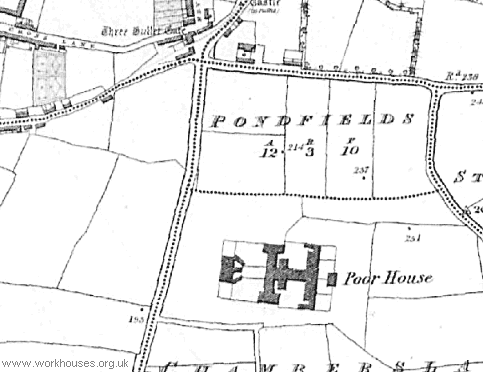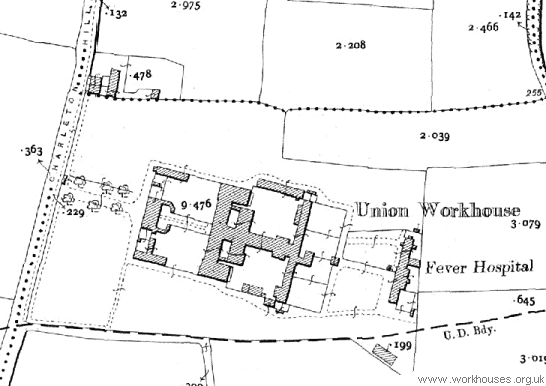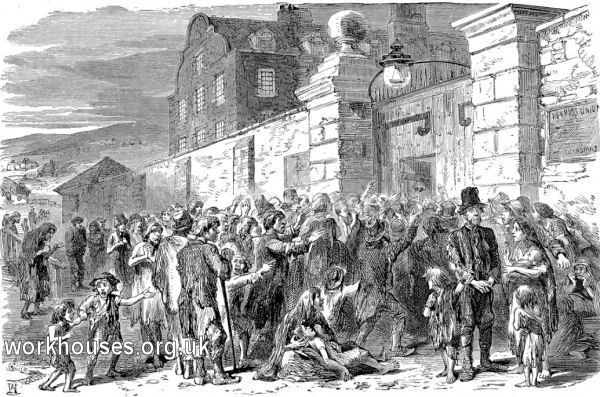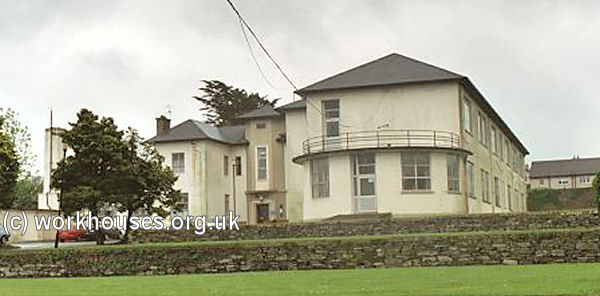New Ross, Co. Wexford
New Ross Poor Law Union was formally declared on the 30th March 1840 and covered an area of 291 square miles. Its operation was overseen by an elected Board of Guardians, 30 in number, representing its 19 electoral divisions as listed below (figures in brackets indicate numbers of Guardians if more than one):
Co. Wexford:
Adamstown, Carnagh, Clongeen, Dunbrody (2), Fethard (2), Horetown, Newbawn, New Ross (4), Old Ross, Templedigan, Tintern (2), Whitechurch.
Co. Carlow:
St Mullins (3).
Co. Kilkenny:
Dysertmoon (2), Graigue (2), Inistiogue, Rosbercon, The Rower, Woodstock (2).
The Board also included 10 ex-officio Guardians, making a total of 40.
The population falling within the Union at the 1831 census had been 67,944 with divisions ranging in size from Adamstown (population 1,643) to New Ross itself (8,833).
The new New Ross Union workhouse was erected in 1841 on a ten-acre site at Charlton Hill to the south of New Ross. Designed by the Poor Law Commissioners' architect George Wilkinson, the building was designed to accommodate 900 inmates. Its construction cost £7,600 plus £1,550 for fittings etc. The site location and layout are shown on the 1839 map below.

New Ross workhouse site, 1839.
The workhouse was declared fit for the reception of paupers on 21st December 1841, and received its first admissions on 6th July 1842.
The buildings followed Wilkinson's typical layout. At the west of the site was an entrance and administrative block contained a porter's room and waiting room with the Guardians' board room on the first floor above. Boys' and girls' school wings were later at each side. To the rear, the main accommodation block had the Master's quarters at the centre, with male and female wings to each side. A central spine containing the chapel and dining-hall linked to the original hospital and idiots' wards.
During the famine in the mid-1840s, sheds were erected to accommodate an additional 28 inmates. A house was hired to accommodate a further 80. A building was hired as a temporary fever hospital accommodating 70 patients. A 72-bed fever hospital was erected at the east of the workhouse, later extended with an additional 22-bed ward.
The layout of the workhouse site in 1902 is shown on the map below.

New Ross workhouse site, 1902.
In 1886, the New Ross Board of Guardians became indirectly involved in the Irish National League's 'Plan of Campaign' which aimed to support agricultural tenants who were being charged excessive rents and evicted from their land. Since 1848, evicted tenants had been entitled to up to a year's out-relief at the same level it was given to the non-able-bodied destitute. Boards of Guardians with a nationalist leaning proved particularly ready to offer relief to such applicants. Since the burden for these payments eventually lay with the rate-paying landowners, the Plan of Campaign's supporters encouraged tenants to withhold rents and thus invite eviction. The landowners would thus be deprived of their rents and also be paying for the relief of those they had evicted. Although admission into the workhouse could also to be offered to evicted tenants, it had generally been seen as a demeaning form of relief. That changed in August 1886, when eleven families evicted by the Marquess of Ely were welcomed — almost as honoured guests — into the New Ross workhouse. The new arrivals were placed is separate quarters (referred to by some as the 'Ward of Honour') and allowed to stay together in their family groups. They were also able to keep their own clothing and to receive food and visitors from outside.
Not surprisingly, the Local Government Board reacted by dissolving the Board of Guardians and appointing paid vice-guardians to run the union in their place. The vice-guardians were hindered in this task in a number of ways: there was a rates boycott amongst supporters of the campaign; local dealers refused to supply the union; most of the workhouse staff resigned from their posts; claimants on out-relief clamoured at the workhouse gates after the officials could not provide their money or food. Things came to the boil on 17th February 1887 when more than a hundred women armed with sticks and stones attacked the vice-guardians and the stand-in workhouse master.
The vice-guardians persisted in the restoring the workhouse operation to that required by official regulations although they met one of the evictees' complaints by providing separate accommodation for married women and for single mothers. Eventually, on 1st June, some of the evictees were discharged on the grounds that they were able-bodied men who should have no difficulty in obtaining employment. Soon afterwards, all the evictees had departed to their homes but were initially branded by the National League as cowards. Nonetheless, a few months later, the tenants were offered a fifty per cent reduction in their rents and again proclaimed as nationalist heroes. The following March, almost all of the original guardians were re-elected unopposed and returned to office.
The contemporary illustration below depicts protestors at the door of the workhouse. However, the appearance of the workhouse itself is entirely fanciful and bears no resemblance to the actual building.

New Ross workhouse protests, 1887.
Following the creation of the Irish Free State, the workhouse closed in 1923. In 1925, Kilkenny, Wexford, Waterford and Carlow Boards of Health had discussions about opening an inter-county mother and baby home at the site. The plan envisaged that all women admitted to the institution would be employed in industries such as mattress covering and shirt-making to supply other institutions in the participating counties. However, the scheme did not come to fruition. However, a District Hospital was established in the male half of the the workhouse infirmary.
The fever hospital was rebuilt in 1936 and run by the St John of God Sisters until 1984. After a refurbishment it became the New Houghton geriatric hospital. The other workhouse buildings no longer exist and the New Ross Community Hospital now occupies the site.

New Ross former fever hospital site from the west, 2002
© Peter Higginbotham.
Records
Note: many repositories impose a closure period of up to 100 years for records identifying individuals. Before travelling a long distance, always check that the records you want to consult will be available.
- Wexford County Archive Service, 6A Ardcavan Business Park, Ardcavan, Co. Wexford. Visitors by prior appointment only.
Bibliography
- Crossman, V (2006) Politics, Pauperism and Power in Late Nineteenth-century Ireland
- Gray, P (2009) The Making of the Irish Poor Law, 1815-43
- O'Connor, J (1995) The Workhouses of Ireland
Links
- None.
Unless otherwise indicated, this page () is copyright Peter Higginbotham. Contents may not be reproduced without permission.


